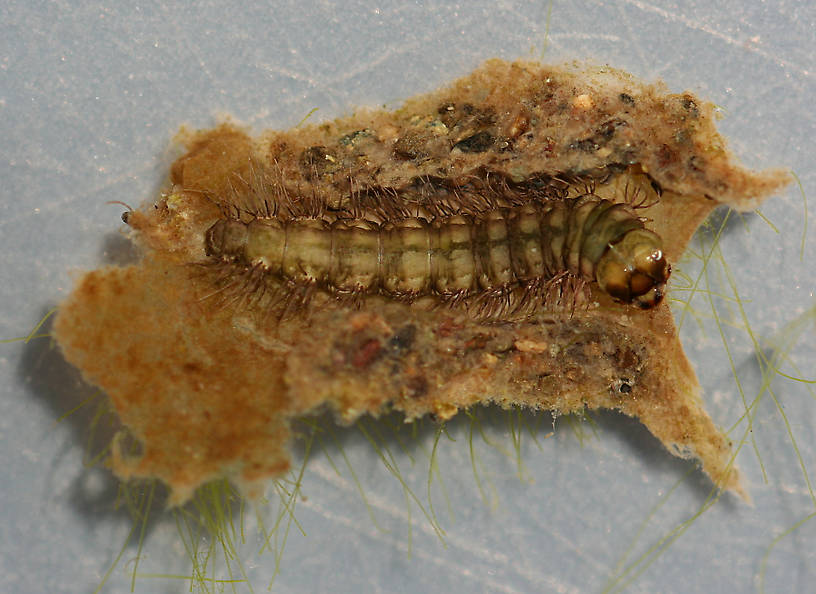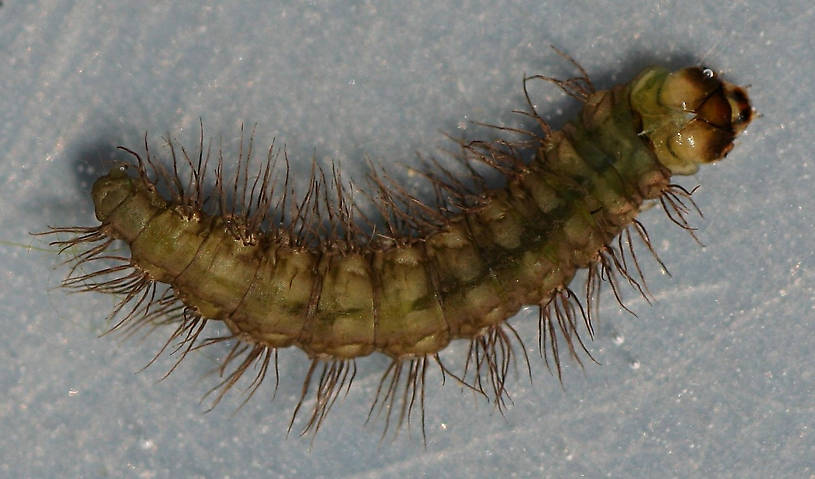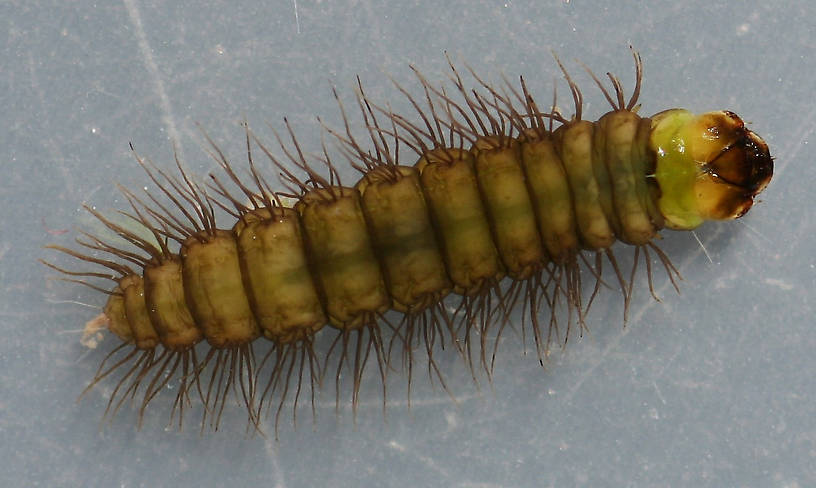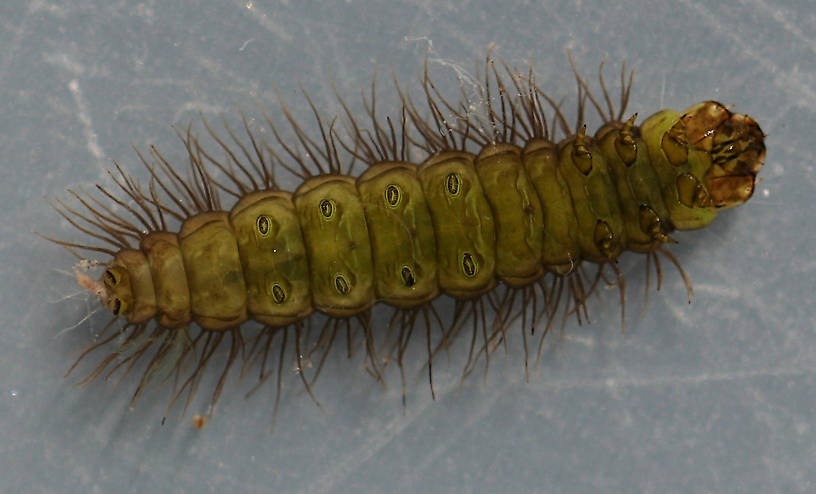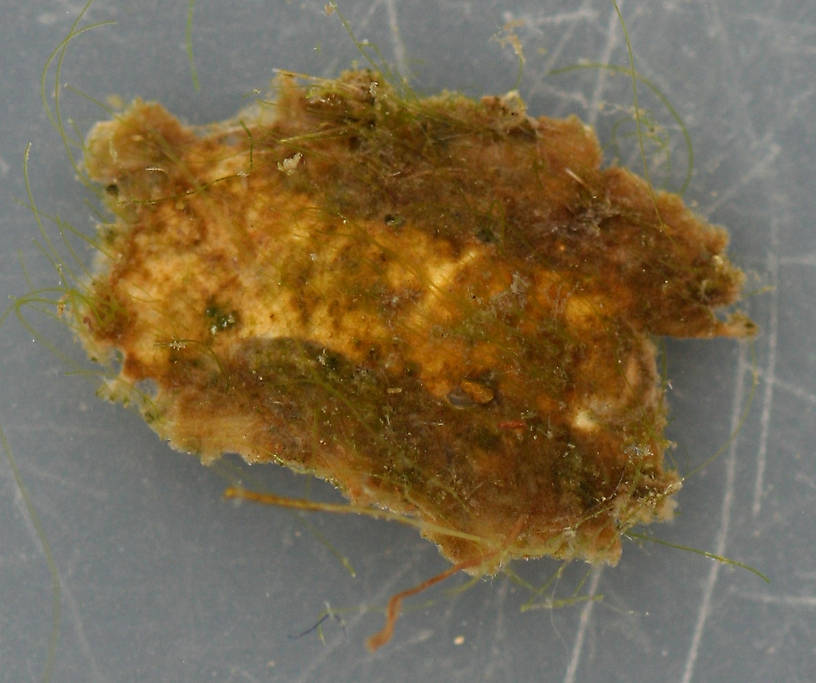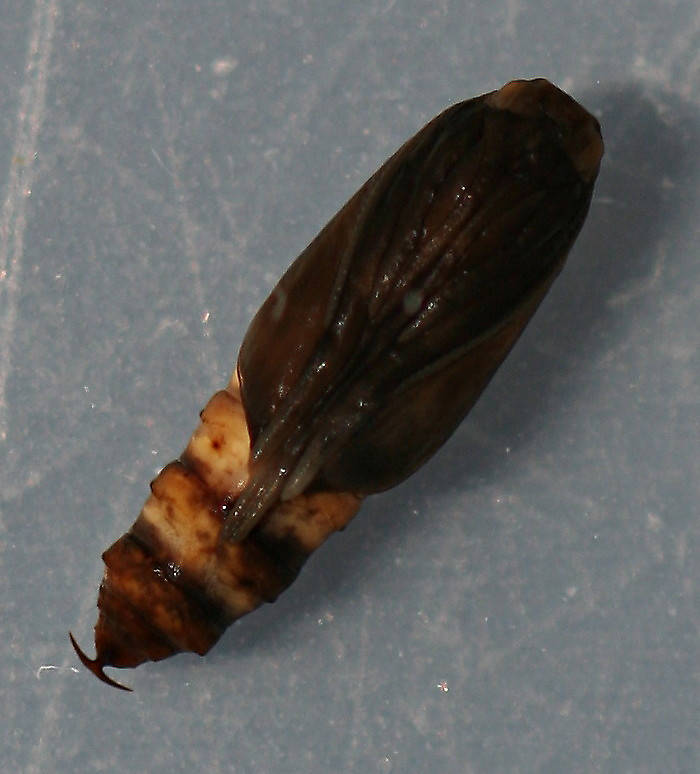Blog & Latest Updates
Fly Fishing Articles
Insects by Common Name


> > Petrophila larvae and pupae
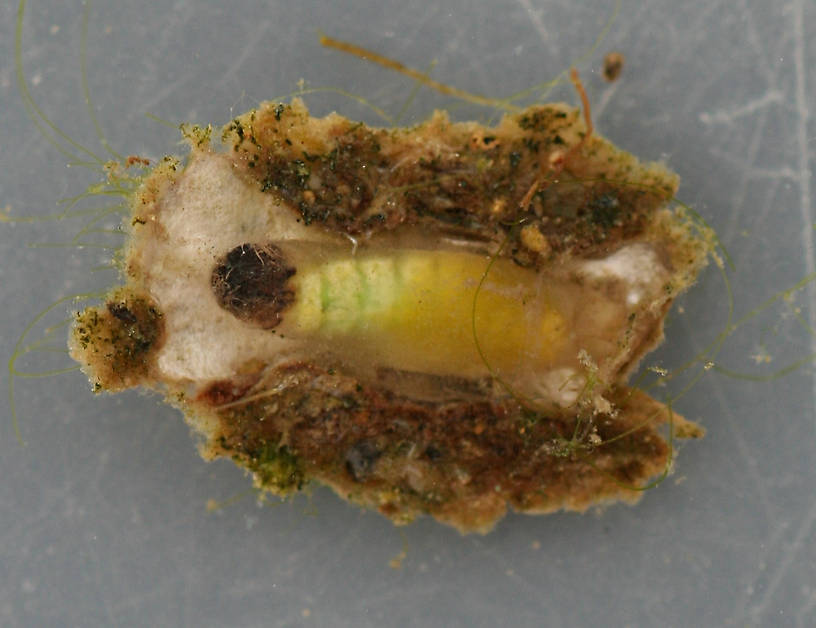
Early stage pupae and case. Pupa approximately 9mm. In alcohol. Ventral view.
| Millcreek | August 13th, 2014, 1:17 pm | |
| Healdsburg, CA Posts: 356 | I've been finding these at the Russian River over the last few days. I was looking for caddisfly pupae and happened to notice mats of silk about the size of pennies or nickels on the top and sides of large pieces of cobble. Got curious and looked underneath a few and found these larvae and pupae which keyed out to Petrophila in Merritt, Cummins and Berg (2008). No idea what the species is. I haven't noticed any adults yet although some of the pupae look like they're about ready to emerge. Found an interesting article on fishing the hatch in old issue of American Angler. It can be seen here http://cpw.state.co.us/Documents/LandWater/Riverwatch/EntomologyContents/AquaticMoths.pdf | |
| Crepuscular | August 13th, 2014, 1:59 pm | |
| Boiling Springs, PA Posts: 923 | NICE! cool find. Aquatic lepidoptera seem to be few and far between here. Nice shot of the ventral aspect of the larva. Neat to be able to see the crochets. | |
| Taxon | August 13th, 2014, 2:34 pm | |
Site Editor Royse City, TXPosts: 1350 | Very nice, Mark. | |
| Best regards, Roger Rohrbeck www.FlyfishingEntomology.com | ||
| Millcreek | August 13th, 2014, 2:38 pm | |
| Healdsburg, CA Posts: 356 | Eric - Yeah, I was real happy to find these, I'd never seen them before. Felt like a bit of a dumbass though since they're there in large numbers and I'd never noticed them before. All I can say in defense is that they're well camouflaged. | |
| Millcreek | August 13th, 2014, 2:42 pm | |
| Healdsburg, CA Posts: 356 | Very nice, Mark. Thanks, Roger. Any idea as to species? | |
| Taxon | August 13th, 2014, 4:42 pm | |
Site Editor Royse City, TXPosts: 1350 | Hi Mark-Thanks, Roger. Any idea as to species? Although you will probably need to capture an adult in order to make a species level identification, Aquatic Insects Of California does has species level keys under the earlier genus name of Parargyractis. | |
| Best regards, Roger Rohrbeck www.FlyfishingEntomology.com | ||
| Millcreek | August 13th, 2014, 5:47 pm | |
| Healdsburg, CA Posts: 356 | Roger -Although you will probably need to capture an adult in order to make a species level identification, Aquatic Insects Of California does has species level keys under the earlier genus name of Parargyractis. I've got a copy of that. Don't know why I didn't think of it. Looks like quite a bit of info on Petrophila under Parargyractis. Thanks. | |
| Lastchance | August 13th, 2014, 5:54 pm | |
| Portage, PA Posts: 437 | Another sulfur. | |
| PaulRoberts | August 13th, 2014, 7:51 pm | |
| Colorado Posts: 1776 | Amazing. Are those some type of gill filaments around spiracles? | |
| Crepuscular | August 13th, 2014, 8:45 pm | |
| Boiling Springs, PA Posts: 923 | Amazing. Are those some type of gill filaments around spiracles? Paul, are you referring to the elongated structures on the sides of the larva or the crochets on the prolegs in the photo of the ventral side? | |
| Millcreek | August 13th, 2014, 9:02 pm | |
| Healdsburg, CA Posts: 356 | Paul - If you're asking about the filamentous structures on the lateral part of the larvae they're gills. Not sure about the larvae having spiracles, if they are present it's difficult to see them. The pupae have very noticeable spiracles, unfortunately they're easiest to see on the side and the only photo I posted shows a ventral view. If you're asking about the structures on the ventral area of the larva those are prolegs with the "claws" arranged around an oval area. | |
| PaulRoberts | August 14th, 2014, 1:19 am | |
| Colorado Posts: 1776 | I was meaning the lateral filaments. They are arranged along the body in similar places as spiracules. Just curious as to whether they are associated with spiracules, or anatomically unique. Are hellgrammite gills the same anatomically? Don't go out of your way to answer (I can do that) -just curious. | |
| Millcreek | August 14th, 2014, 10:49 am | |
| Healdsburg, CA Posts: 356 | I was reading up on these larvae last night and the lateral filaments are indeed gills associated with spiracles. I went back to the microscope and there are spiracles located in between the gills although they are difficult to see on the larvae. In the taxonomic literature on Petrophila larvae the arrangement of the filamentous gills around the spiracles is used as a diagnostic feature. I don't know if hellgrammite gills are similar but I'd be interested to hear what you find out. | |
| PaulRoberts | August 17th, 2014, 8:43 pm | |
| Colorado Posts: 1776 | Found this on Corydalus: http://entnemdept.ufl.edu/creatures/misc/eastern_dobsonfly.htm "Abdominal segments 1 through 8 have lateral tactile filaments which function to protect them from each other and from other small predators (Neunzig and Baker 1991), and segments 1 through 7 each has a pair of ventro-lateral tufts of tracheal gills that absorb dissolved oxygen (Barclay et al. 2005, Hoover et al. 1988). In addition to the tracheal gills, larvae also have spiracles allowing them to breathe both in and out of water. There are two prolegs at the tip of the abdomen -- each with a dorsal filament and a pair of terminal hooks to help the larvae anchor themselves to the substrate. The mandibles are powerful and heavily sclerotized." | |
| Millcreek | August 18th, 2014, 10:14 am | |
| Healdsburg, CA Posts: 356 | Paul - Thanks for the info. Looks like the filaments serve different purposes. | |
| Millcreek | August 24th, 2014, 12:55 pm | |
| Healdsburg, CA Posts: 356 | Probably of no interest except for the bug geeks on the site but apparently if you find Petrophila larvae you have a chance of finding an aquatic Hymenoptera parasite as well. Paper on it is here http://biostor.org/cache/pdf/05/10/a7/0510a77977bda72401f5a277cf4fa2ac.pdf. | |
| Crepuscular | August 24th, 2014, 10:55 pm | |
| Boiling Springs, PA Posts: 923 | Probably of no interest except for the bug geeks on the site but apparently if you find Petrophila larvae you have a chance of finding an aquatic Hymenoptera parasite as well. Paper on it is here http://biostor.org/cache/pdf/05/10/a7/0510a77977bda72401f5a277cf4fa2ac.pdf. Nice. Vince R. Is right, you never hear about aquatic icneumonids or any aquatic Hymenoptera. Ok, now go find us a parasitized one! ;) | |
| Millcreek | August 25th, 2014, 9:52 am | |
| Healdsburg, CA Posts: 356 | Ok, now go find us a parasitized one! ;) Believe me, I've been looking. No luck so far, which I guess is good news for the Petrophila pupae. If you're interested here's a link to some photos I took of some Ecdyonurus criddlei nymphs parasitized by a Symbiocladius (Diptera) species. http://bugguide.net/node/view/877481. | |
| Oldredbarn | August 27th, 2014, 6:10 pm | |
| Novi, MI Posts: 2608 | Nice. Vince R. Is right, you never hear about aquatic icneumonids or any aquatic Hymenoptera. Ok, now go find us a parasitized one! ;) You are going to have to get a life, bro! :) Spence | |
| "Even when my best efforts fail it's a satisfying challenge, and that, after all, is the essence of fly fishing." -Chauncy Lively "Envy not the man who lives beside the river, but the man the river flows through." Joseph T Heywood | ||
Quick Reply
You have to be logged in to post on the forum. It's this easy:
Related Discussions
| Title | Replies | Last Reply |
| Re: need an Id In the Identify This! Board by Sandfly | 14 | Jan 26, 2015 by MiltRPowell |
| Re: identification needed In Rhithrogena impersonata Mayfly Nymph by Kinza | 2 | Feb 6, 2017 by Crepuscular |
| Re: Helgramite? In the Identify This! Board by Pbaerman | 5 | May 10, 2007 by Taxon |
| Re: Guess this nymph In the Identify This! Board by Troutnut | 7 | Jul 19, 2011 by Troutnut |
| Gills In General Discussion by Wbranch | 0 | |
| Re: What is it? In the Identify This! Board by Wbranch | 9 | Jul 24, 2007 by GONZO |
| Re: Could be Himalopsyche? In Rhyacophila brunnea Caddisfly Larva by Litobrancha | 1 | Sep 5, 2006 by Troutnut |
| Re: Early Colorado Caddis In the Identify This! Board by PaulRoberts | 14 | May 10, 2012 by PaulRoberts |
| Re: trying to figure out In the Insect Family Corydalidae by Buggy | 1 | Apr 19, 2009 by GONZO |
| Re: Anyone know your western Drunella species? In Female Drunella doddsii Mayfly Dun by Troutnut | 23 | Apr 12, 2012 by Entoman |
Troutnut.com is copyright © 2004-2024 Jason
Neuswanger (email Jason). See my FAQ for information about use of my images.
 privacy policy
privacy policy

